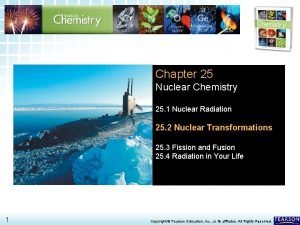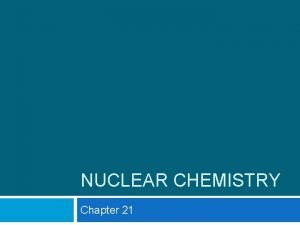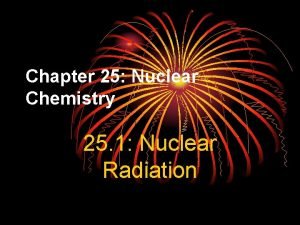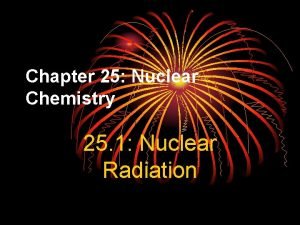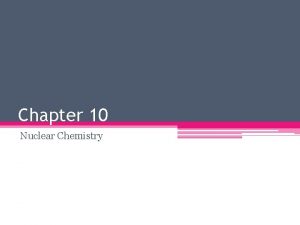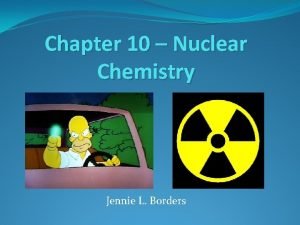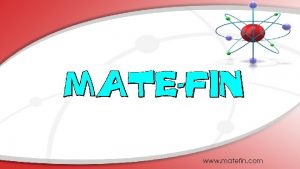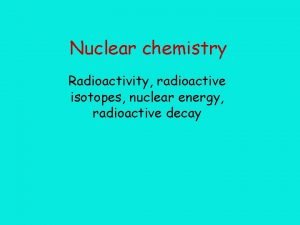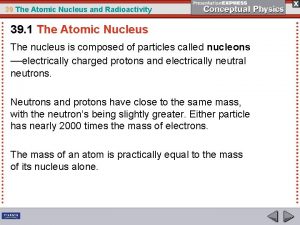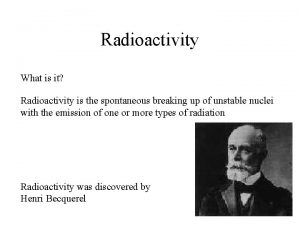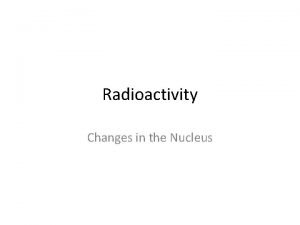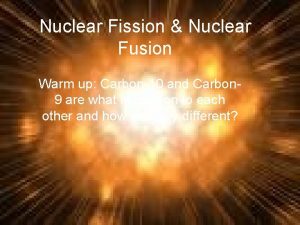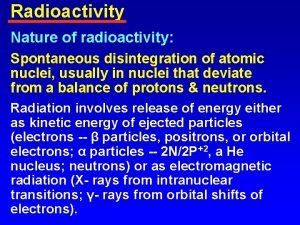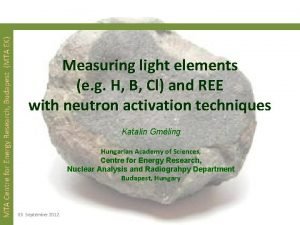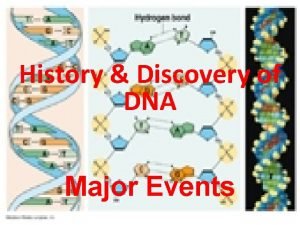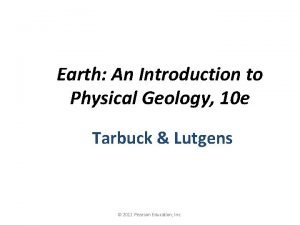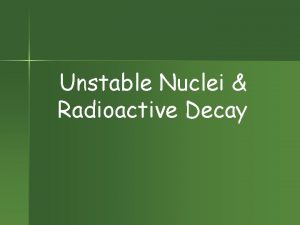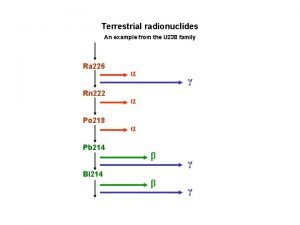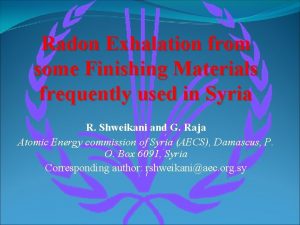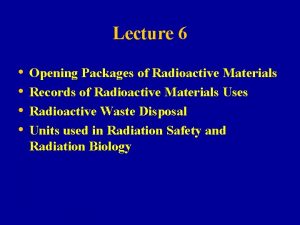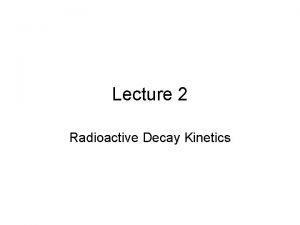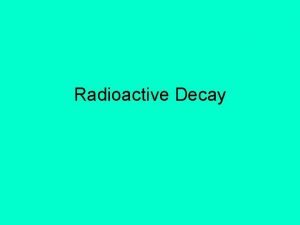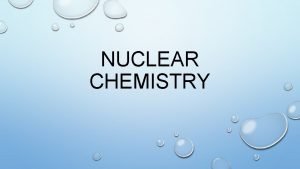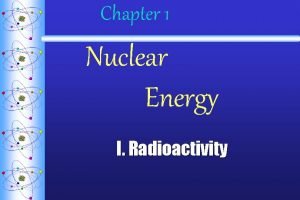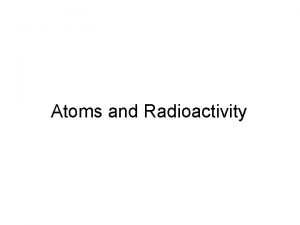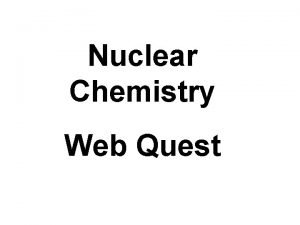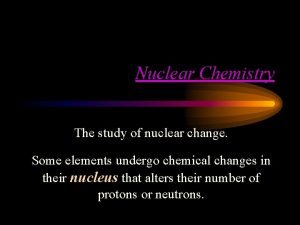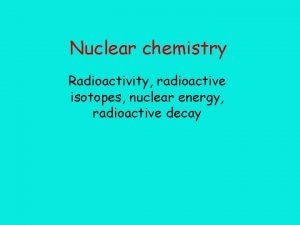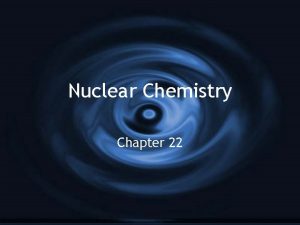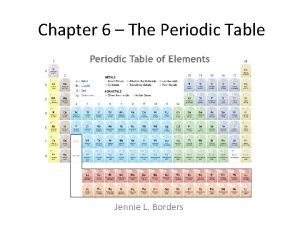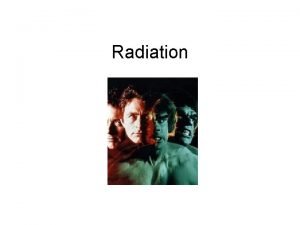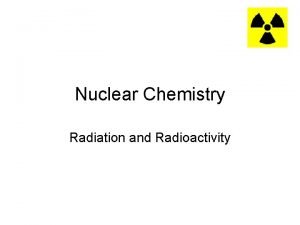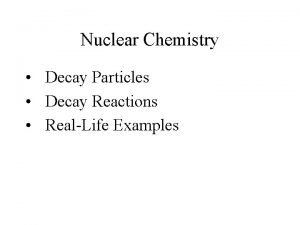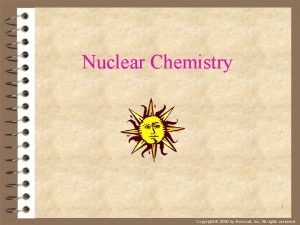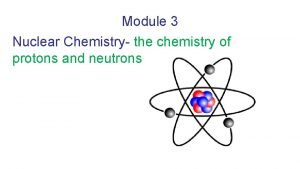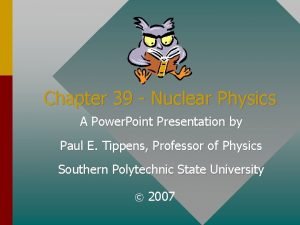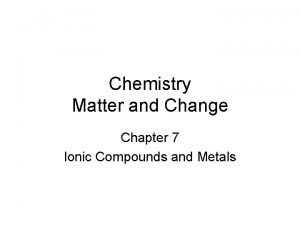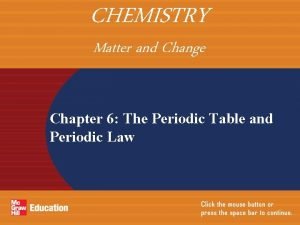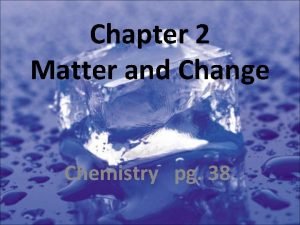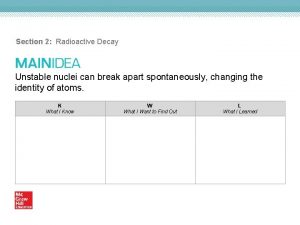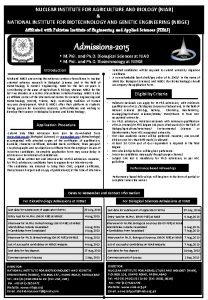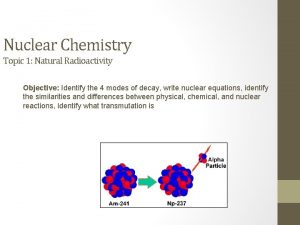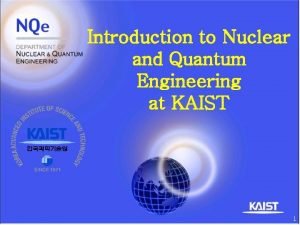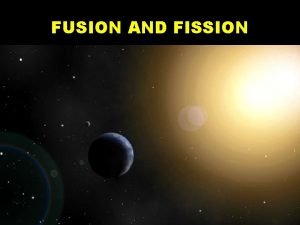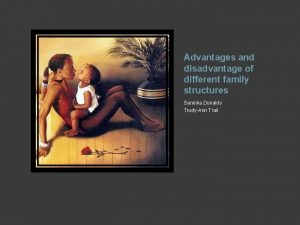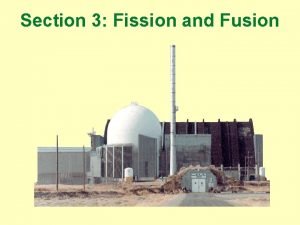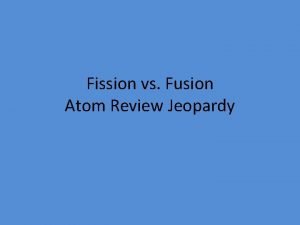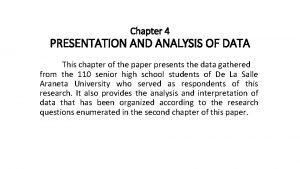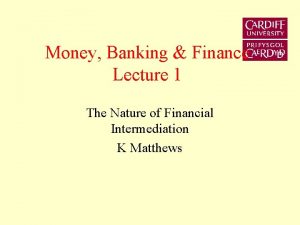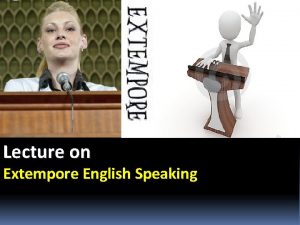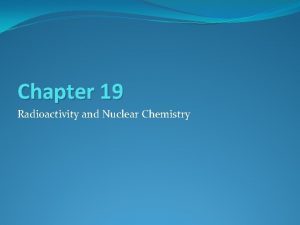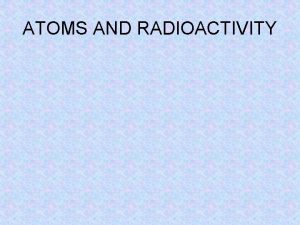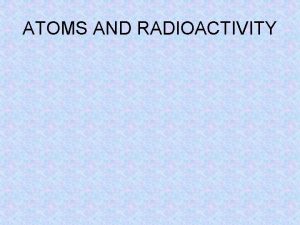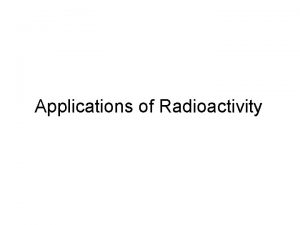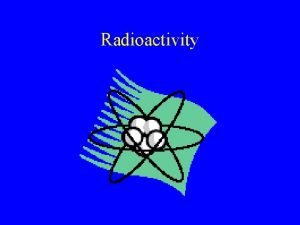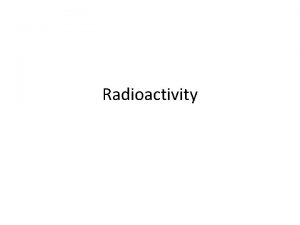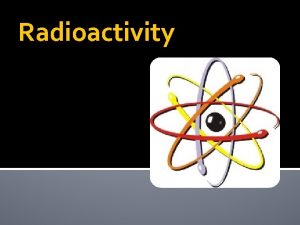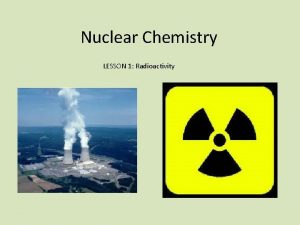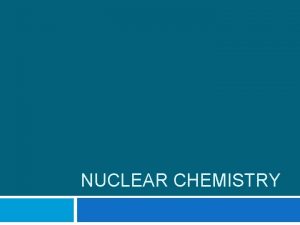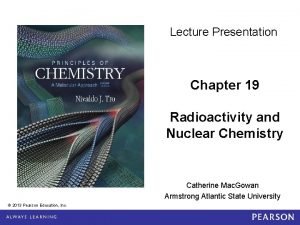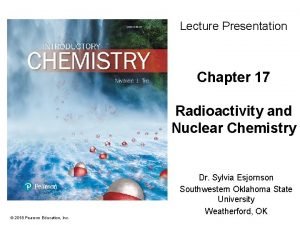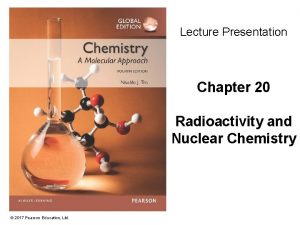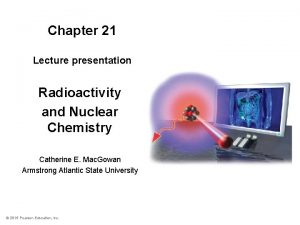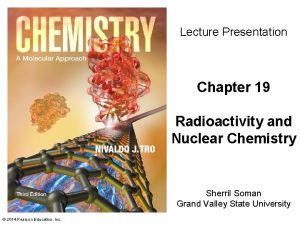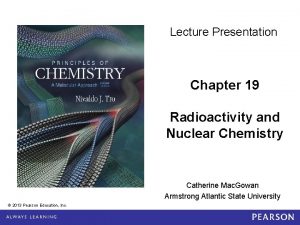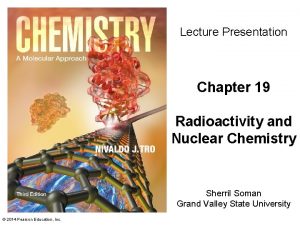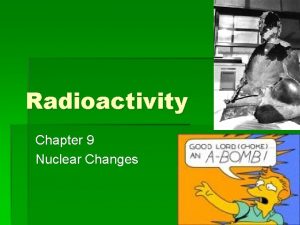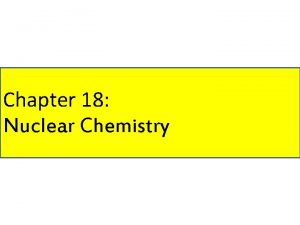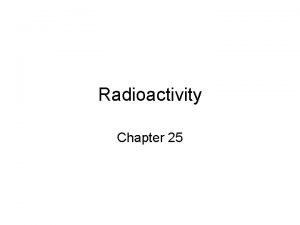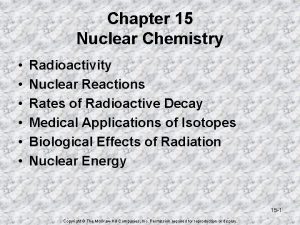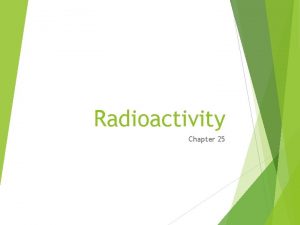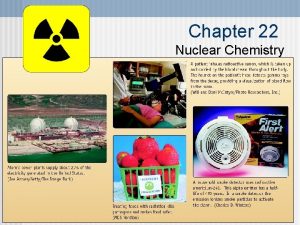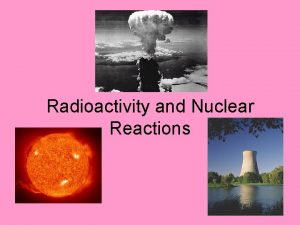Lecture Presentation Chapter 19 Radioactivity and Nuclear Chemistry


























































































- Slides: 90

Lecture Presentation Chapter 19 Radioactivity and Nuclear Chemistry Sherril Soman Grand Valley State University © 2014 Pearson Education, Inc.

Nuclear Medicine • Changes in the structure of the nucleus are used in many ways in medicine. • Nuclear radiation can be used to visualize or test structures in your body to see if they are operating properly. – For example, labeling atoms so their intake and output can be monitored • Nuclear radiation can also be used to treat diseases because the radiation is ionizing, allowing it to attack unhealthy tissue. © 2014 Pearson Education, Inc.

The Discovery of Radioactivity • Antoine-Henri Becquerel designed an experiment to determine if phosphorescent minerals also gave off X-rays. – Phosphorescence is the longlived emission of light by atoms or molecules that sometimes occurs after they absorb light. – X-rays are detected by their ability to penetrate matter and expose a photographic plate. © 2014 Pearson Education, Inc.

Discovery of Radioactivity: Becquerel • Becquerel discovered that certain minerals were constantly producing energy rays that could penetrate matter. • Becquerel determined that 1. all the minerals that produced these rays contained uranium, and 2. the rays were produced even though the mineral was not exposed to outside energy. • He called them uranic rays because they were emitted from minerals that contained uranium. ü Like X-rays ü Not related to phosphorescence © 2014 Pearson Education, Inc.

Discovery of Radioactivity: Marie Curie • Marie Curie determined the rays were emitted from specific elements. • She also discovered new elements by detecting their rays. ü Radium named for its green phosphorescence ü Polonium named for her homeland • Because these rays were no longer just a property of uranium, she renamed it radioactivity. © 2014 Pearson Education, Inc.

Other Properties of Radioactivity • Radioactive rays can ionize matter. üCause uncharged matter to become charged üBasis of Geiger counter and electroscope • Radioactive rays have high energy. • Radioactive rays can penetrate matter. • Radioactive rays cause phosphorescent chemicals to glow. üBasis of scintillation counter © 2014 Pearson Education, Inc.

What Is Radioactivity? • Radioactivity is the release of tiny, highenergy particles or gamma rays from an atom. • Particles are ejected from the nucleus. © 2014 Pearson Education, Inc.

Types of Radioactive Decay • Rutherford discovered three types of rays: ü Alpha (a) rays ØHave a charge of +2 and a mass of 4 amu ØWhat we now know to be helium nucleus ü Beta (b) rays ØHave a charge of − 1 c. u. and negligible mass ØElectron-like ü Gamma (g) rays ØForm of light energy (not a particle like a and b) • In addition, some unstable nuclei emit positrons. ü Like a positively charged electron • Some unstable nuclei will undergo electrons capture. ü A low energy electron is pulled into the nucleus. © 2014 Pearson Education, Inc.

Rutherford’s Experiment ++++++ g b a ------- © 2014 Pearson Education, Inc.

Penetrating Ability of Radioactive Rays a g b 0. 01 mm Pieces of Lead © 2014 Pearson Education, Inc. 100 mm

Facts about the Nucleus • Very small volume compared to volume of the atom • Essentially entire mass of atom • Very dense • Composed of protons and neutrons that are tightly held together – The particles that make up the nucleus are called nucleons. © 2014 Pearson Education, Inc.

Facts about the Nucleus • Every atom of an element has the same number of protons. – Atomic number (Z) • Atoms of the same elements can have different numbers of neutrons. – Isotopes – Different atomic masses • Isotopes are identified by their mass number (A). – Mass number = number of protons + neutrons © 2014 Pearson Education, Inc.

Facts about the Nucleus • The number of neutrons is calculated by subtracting the atomic number from the mass number. • The nucleus of an isotope is called a nuclide. – Less than 10% of the known nuclides are nonradioactive; most are radionuclides. • Each nuclide is identified by a symbol. – Element – mass number = X – A © 2014 Pearson Education, Inc.

Radioactivity • Radioactive nuclei spontaneously decompose into smaller nuclei— radioactive decay. – We say that radioactive nuclei are unstable. – Decomposing involves the nuclide emitting a particle and/or energy. • The parent nuclide is the nucleus that is undergoing radioactive decay. • The daughter nuclide is the new nucleus that is made. • All nuclides with 84 or more protons are radioactive. © 2014 Pearson Education, Inc.

Important Atomic Symbols © 2014 Pearson Education, Inc.

Transmutation • Rutherford discovered that during the radioactive process, atoms of one element are changed into atoms of a different element —transmutation. ü Showing that statement three of Dalton’s atomic theory is not valid all the time, only for chemical reactions • For one element to change into another, the number of protons in the nucleus must change! © 2014 Pearson Education, Inc.

Chemical Processes versus Nuclear Processes • Chemical reactions involve changes in the electronic structure of the atom. – Atoms gain, lose, or share electrons. – No change in the nuclei occurs. • Nuclear reactions involve changes in the structure of the nucleus. – When the number of protons in the nucleus changes, the atom becomes a different element. © 2014 Pearson Education, Inc.

Nuclear Equations • We describe nuclear processes with nuclear equations. • Atomic numbers and mass numbers are conserved. – The sum of the atomic numbers on both sides must be equal. – The sum of the mass numbers on both sides must be equal. © 2014 Pearson Education, Inc.

Alpha Decay • Occurs when an unstable nucleus emits a particle composed of two protons and two neutrons • Most ionizing, but least penetrating of the types of radioactivity • Loss of an alpha particle means ü the atomic number decreases by 2, and ü the mass number decreases by 4. © 2014 Pearson Education, Inc.

© 2014 Pearson Education, Inc.

Beta Decay • Occurs when an unstable nucleus emits an electron • About 10 times more penetrating than α, but only about half the ionizing ability • When an atom loses a β particle its ü atomic number increases by 1, and ü the mass number remains the same. © 2014 Pearson Education, Inc.

© 2014 Pearson Education, Inc.

Gamma Emission • Gamma (g) rays are high energy photons of light. • No loss of particles from the nucleus • No change in the composition of the nucleus üSame atomic number and mass number • Least ionizing, but most penetrating • Generally occurs after the nucleus undergoes some other type of decay and the remaining particles rearrange © 2014 Pearson Education, Inc.

Positron Emission • Positron has a charge of +1 and a negligible mass. ü Antielectron • Similar to beta particles in their ionizing and penetrating ability • When an atom loses a positron from the nucleus, its ü mass number remains the same, and ü its atomic number decreases by 1. • Positrons result from a proton changing into a neutron. © 2014 Pearson Education, Inc.

© 2014 Pearson Education, Inc.

Electron Capture • Occurs when an inner orbital electron is pulled into the nucleus. • No particle emission, but atom changes ü Same result as positron emission • When a proton combines with the electron to make a neutron its ü mass number stays the same, and ü its atomic number decreases by 1. © 2014 Pearson Education, Inc.

© 2014 Pearson Education, Inc.

Nuclear Equations • In the nuclear equation, mass numbers and atomic numbers are conserved. • We can use this fact to determine the identity of a daughter nuclide if we know the parent and mode of decay. © 2014 Pearson Education, Inc.

What Causes Nuclei to Decompose? • The particles in the nucleus are held together by a very strong attractive force only found in the nucleus called the strong force. – Acts only over very short distances • The neutrons play an important role in stabilizing the nucleus, as they add to the strong force, but don’t repel each other like the protons do. © 2014 Pearson Education, Inc.

N/Z Ratio • The ratio of neutrons : protons is an important measure of the stability of the nucleus. • If the N/Z ratio is too high, neutrons are converted to protons via b decay. • If the N/Z ratio is too low, protons are converted to neutrons via positron emission or electron capture. – Or via a decay, though not as efficiently © 2014 Pearson Education, Inc.

Valley of Stability For Z = 1 ⇒ 20, stable N/Z ≈ 1. © 2014 Pearson Education, Inc.

Valley of Stability For Z = 1 ⇒ 20, stable N/Z ≈ 1. For Z = 20 ⇒ 40, stable N/Z approaches 1. 25. © 2014 Pearson Education, Inc.

Valley of Stability For Z = 1 ⇒ 20, stable N/Z ≈ 1. For Z = 20 ⇒ 40, stable N/Z approaches 1. 25. For Z = 40 ⇒ 80, stable N/Z approaches 1. 5. © 2014 Pearson Education, Inc.

Valley of Stability For Z = 1 ⇒ 20, stable N/Z ≈ 1. For Z = 20 ⇒ 40, stable N/Z approaches 1. 25. For Z = 40 ⇒ 80, stable N/Z approaches 1. 5. For Z > 83, there are no stable nuclei. © 2014 Pearson Education, Inc.

Magic Numbers • Besides the N/Z ratio, the actual numbers of protons and neutrons affect stability. • Most stable nuclei have even numbers of protons and neutrons. • Only a few have odd numbers of protons and neutrons. • If the total number of nucleons adds to a magic number, the nucleus is more stable. – Same principle as stability of the noble gas electron configuration – Most stable when N or Z = 2, 8, 20, 28, 50, 82; or N = 126 © 2014 Pearson Education, Inc.

Decay Series • In nature, often one radioactive nuclide changes into another radioactive nuclide. ü That is, the daughter nuclide is also radioactive. • All atoms with Z > 83 are radioactive. • All of the radioactive nuclides that are produced one after the other until a stable nuclide is made is called a decay series. © 2014 Pearson Education, Inc.

U-238 Decay Series © 2014 Pearson Education, Inc.

Natural Radioactivity • There are small amounts of radioactive minerals in the air, ground, and water. • They are even in the food you eat! • The radiation you are exposed to from natural sources is called background radiation. © 2014 Pearson Education, Inc.

Detecting Radioactivity Particles emitted by radioactive nuclei have a lot of energy and therefore can be readily detected. • Radioactive rays can expose light-protected photographic film. • We may use photographic film to detect the presence of radioactive rays—film badge dosimeters. © 2014 Pearson Education, Inc.

Detecting Radioactivity • • • Radioactive rays cause air to become ionized. An electroscope detects radiation by its ability to penetrate the flask and ionize the air inside. A Geiger-Müller counter works by counting electrons generated when Ar gas atoms are ionized by radioactive rays. © 2014 Pearson Education, Inc.

Detecting Radioactivity • Radioactive rays cause certain chemicals to give off a flash of light when they strike the chemical. • A scintillation counter is able to count the number of flashes per minute. © 2014 Pearson Education, Inc.

Rate of Radioactive Decay • The rate of change in the amount of radioactivity is constant, and is different for each radioactive “isotope. ” ü Change in radioactivity measured with Geiger counter Ø Counts per minute • Each radionuclide had a particular length of time it required to lose half its radioactivity—a constant half-life. ü We know that processes with a constant half-life follow first order kinetic rate laws. • The rate of radioactive change was not affected by temperature. ü In other words, radioactivity is not a chemical reaction! © 2014 Pearson Education, Inc.

Kinetics of Radioactive Decay • Rate = k. N – N = number of radioactive nuclei • The shorter the half-life, the more nuclei decay every second; therefore, we say the sample is “hotter. ” © 2014 Pearson Education, Inc.

Half-Lives of Various Nuclides © 2014 Pearson Education, Inc.

Half-Life Half of the radioactive atoms decay each half-life. © 2014 Pearson Education, Inc.

Kinetics of Radioactive Decay • Radioactive decay is a first order process. • Nt = number of radioactive nuclei at time, t • N 0 = initial number of radioactive nuclei © 2014 Pearson Education, Inc.

Radiometric Dating • The change in the amount of radioactivity of a particular radionuclide is predictable and not affected by environmental factors. • By measuring and comparing the amount of a parent radioactive isotope and its stable daughter, we can determine the age of the object. ü Using the half-life and the previous equations • Mineral (geological) dating ü Compare the amount of U-238 to Pb-206 in volcanic rocks and meteorites. Ø Dates Earth to between 4. 0 and 4. 5 billion years old ü Compare amount of K-40 to Ar-40. © 2014 Pearson Education, Inc.

Radiocarbon Dating • All things that are alive or were once alive contain carbon. • Three isotopes of carbon exist in nature, one of which, C-14, is radioactive. ü C-14 radioactive with half-life = 5730 years • Atmospheric chemistry keeps producing C-14 at nearly the same rate it decays. © 2014 Pearson Education, Inc.

Radiocarbon Dating • While still living, C-14/C-12 is constant because the organism replenishes its supply of carbon. ü CO 2 in air is the ultimate source of all C in an organism. • Once the organism dies the C-14/C-12 ratio decreases. • By measuring the C-14/C-12 ratio in a once living artifact and comparing it to the C-14/C-12 ratio in a living organism, we can tell how long ago the organism was alive. • The limit for this technique is 50, 000 years old. ü About 9 half-lives, after which radioactivity from C-14 will be below the background radiation © 2014 Pearson Education, Inc.

Nonradioactive Nuclear Changes • Fission – The large nucleus splits into two smaller nuclei. • Fusion – Small nuclei can be accelerated to smash together to make a larger nucleus. • Both fission and fusion release enormous amounts of energy. ü Fusion releases more energy per gram than fission. © 2014 Pearson Education, Inc.

Nuclear Fission © 2014 Pearson Education, Inc.

Fission Chain Reaction • A chain reaction occurs when a reactant in the process is also a product of the process. ü In the fission process it is the neutrons. ü So, you only need a small amount of neutrons to start the chain. • Many of the neutrons produced in fission are either ejected from the uranium before they hit another U-235 or are absorbed by the surrounding U-238. • The minimum amount of fissionable isotope needed to sustain the chain reaction is called the critical mass. © 2014 Pearson Education, Inc.

© 2014 Pearson Education, Inc.

Fissionable Material • Fissionable isotopes include U-235, Pu-239, and Pu-240. • Natural uranium is less than 1% U-235. ü Rest mostly U-238 ü Not enough U-235 to sustain chain reaction • To produce fissionable uranium, the natural uranium must be enriched in U-235. ü To about 7% for “weapons grade” ü To about 3% for reactor grade © 2014 Pearson Education, Inc.

Nuclear Power • Nuclear reactors use fission to generate electricity. – About 20% of U. S. electricity – Uses the fission of U-235 to produce heat • The heat boils water, turning it to steam. • The steam turns a turbine, generating electricity. © 2014 Pearson Education, Inc.

Nuclear Power Plants versus Coal-Burning Power Plants • Use about 50 kg of fuel to generate enough electricity for 1 million people • Use about 2 million kg of fuel to generate enough electricity for 1 million people • No air pollution • Produce NO 2 and SOx that add to acid rain • Produce CO 2 that adds to the greenhouse effect © 2014 Pearson Education, Inc.

Nuclear Power Plants – Core • The fissionable material is stored in long tubes, called fuel rods, arranged in a matrix. ü Subcritical • Between the fuel rods are control rods made of neutron-absorbing material. ü B and/or Cd ü Neutrons needed to sustain the chain reaction • The rods are placed in a material to slow down the ejected neutrons, called a moderator. ü Allows chain reaction to occur below critical mass © 2014 Pearson Education, Inc.

© 2014 Pearson Education, Inc.

Pressurized Light Water Reactor • The design is used in the United States (GE, Westinghouse). • Water is both the coolant and moderator. • Water in the core kept under pressure to keep it from boiling. • Fuel is enriched uranium. ü Subcritical • Containment dome is made of concrete. © 2014 Pearson Education, Inc.

PLWR Containment building Turbine Condenser Boiler Core © 2014 Pearson Education, Inc. Cold water

PLWR – Core The control rods are made of neutron absorbing material. Hot water This allows the rate of neutron flow through Control rods the reactor to be controlled. Because the neutrons are required to continue the chain reaction, the control rods control the rate of nuclear fission. © 2014 Pearson Education, Inc. Fuel rods Cold water

Concerns about Nuclear Power • Core meltdown ü Water loss from core; heat melts core ü China Syndrome ü Chernobyl • Waste disposal ü Waste highly radioactive ü Reprocessing; underground storage? ü Federal High Level Radioactive Waste Storage Facility at Yucca Mountain, Nevada • Transporting waste • How do we deal with nuclear power plants that are no longer safe to operate? ü Yankee Rowe in Massachusetts © 2014 Pearson Education, Inc.

Where Does the Energy from Fission Come From? • During nuclear fission, some of the mass of the nucleus is converted into energy. – E = mc 2 • Each mole of U-235 that fissions produces about 1. 7 × 1013 J of energy. – A very exothermic chemical reaction produces 106 J per mole. © 2014 Pearson Education, Inc.

Mass Defect and Binding Energy • When a nucleus forms, some of the mass of the separate nucleons is converted into energy. • The difference in mass between the separate nucleons and the combined nucleus is called the mass defect. • The energy that is released when the nucleus forms is called the binding energy. – 1 Me. V = 1. 602 × 10− 13 J – 1 amu of mass defect = 931. 5 Me. V – The greater the binding energy per nucleon, the more stable the nucleus. © 2014 Pearson Education, Inc.

Mass Defect and Binding Energy Mass lost (m) = 236. 05258 amu – 235. 86769 amu © 2014 Pearson Education, Inc.

© 2014 Pearson Education, Inc.

Nuclear Fusion • Fusion is the combining of light nuclei to make a heavier, more stable nuclide. • The sun uses the fusion of hydrogen isotopes to make helium as a power source. • It requires high input of energy to initiate the process. – Because need to overcome repulsion of positive nuclei • It produces 10 times the energy per gram as fission. • It produces no radioactive byproducts. • Unfortunately, the only currently working application is the H-bomb. © 2014 Pearson Education, Inc.

Fusion © 2014 Pearson Education, Inc.

Tokamak Fusion Reactor © 2014 Pearson Education, Inc.

Making New Elements: Artificial Transmutation • High energy particles can be smashed into target nuclei, resulting in the production of new nuclei. • The particles may be radiation from another radionuclide, or charged particles that are accelerated. ü Rutherford made O-17 bombarding N-14 with alpha rays from radium. ü Cf-244 is made by bombarding U-238 with C-12 in a particle accelerator. © 2014 Pearson Education, Inc.

Artificial Transmutation • Bombardment of one nucleus with another causing new atoms to be made ü Can also bombard with neutrons • Reaction done in a particle accelerator ü Linear ü Cyclotron © 2014 Pearson Education, Inc.

Linear Accelerator +- + - +- + - +- + - ++ + Source © 2014 Pearson Education, Inc. + Target

Cyclotron © 2014 Pearson Education, Inc.

Effects of Radiation on Life • Radiation has high energy—enough energy to knock electrons from molecules and break bonds. – Ionizing radiation • Energy transferred to cells can damage biological molecules and cause malfunction of the cells. © 2014 Pearson Education, Inc.

Acute Effects of Radiation • High levels of radiation over a short period of time kill large numbers of cells. – From a nuclear blast or exposed reactor core • It causes weakened immune system and lower ability to absorb nutrients from food. – May result in death, usually from infection © 2014 Pearson Education, Inc.

Chronic Effects • Low doses of radiation over a period of time show an increased risk for the development of cancer. – Radiation damages DNA that may not get repaired properly. • Low doses over time may damage reproductive organs, which may lead to sterilization. • Damage to reproductive cells may lead to genetic defects in offspring. © 2014 Pearson Education, Inc.

Measuring Radiation Exposure • The curie (Ci) is an exposure of 3. 7 × 1010 events per second. – No matter the kind of radiation • The gray (Gy) measures the amount of energy absorbed by body tissue from radiation. – 1 Gy = 1 J/kg body tissue • The rad also measures the amount of energy absorbed by body tissue from radiation. – 1 rad = 0. 01 Gy © 2014 Pearson Education, Inc.

Measuring Radiation Exposure • A correction factor is used to account for a number of factors that affect the result of the exposure. • This biological effectiveness factor is the RBE, and the result is the dose in rems. – Rads × RBE = rems – Rem = roentgen equivalent man © 2014 Pearson Education, Inc.

Factors That Determine the Biological Effects of Radiation 1. More energetic radiation has a larger effect. 2. More ionizing radiation penetrates human tissue more deeply. – Gamma >> Beta > Alpha 3. More ionizing radiation has a larger effect. – Alpha > Beta > Gamma 4. Characteristics of the radionuclide are as follows: The radioactive half-life of the radionuclide The biological half-life of the element The physical state of the radioactive material © 2014 Pearson Education, Inc.

© 2014 Pearson Education, Inc.

Biological Effects of Radiation • The amount of danger to humans of radiation is measured in the unit rems. © 2014 Pearson Education, Inc.

Medical Uses of Radioisotopes, Diagnosis • Radiotracers üCertain organs absorb most or all of a particular element. üYou can measure the amount absorbed by using tagged isotopes of the element and a Geiger counter. ØTagged = radioisotope that can then be detected and measured üUse radioisotope with a short half-life üUse radioisotope that is low ionizing ØBeta or gamma © 2014 Pearson Education, Inc.

A Bone Scan © 2014 Pearson Education, Inc.

© 2014 Pearson Education, Inc.

Medical Uses of Radioisotopes, Diagnosis • PET scan üPositron emission tomography üF-18 tagged glucose ØF-18 is a positron emitter. üBrain scan and function © 2014 Pearson Education, Inc.

Medical Uses of Radioisotopes, Treatment – Radiotherapy • Cancer treatment üCancer cells are more sensitive to radiation than healthy cells; radiation can be used to kill cancer cells without doing significant damage. üBrachytherapy Ø Place radioisotope directly at site of cancer. üTeletherapy Ø Use gamma radiation from Co-60 outside to penetrate inside Ø IMRT üRadiopharmaceutical therapy Ø Use radioisotopes that concentrate in one area of the body © 2014 Pearson Education, Inc.

Gamma Ray Treatment © 2014 Pearson Education, Inc.

Nonmedical Uses of Radioactive Isotopes • Smoke detectors ü Am-241 ü Smoke blocks ionized air; breaks circuit • Insect control ü Sterilize males • Food preservation • Radioactive tracers ü Follow progress of a “tagged” atom in a reaction • Chemical analysis ü Neutron activation analysis © 2014 Pearson Education, Inc.

Nonmedical Uses of Radioactive Isotopes • Authenticating art object ü Many older pigments and ceramics were made from minerals with small amounts of radioisotopes. • Crime scene investigation • Measure thickness or condition of industrial materials ü Corrosion ü Track flow through process ü Gauges in high temp processes ü Weld defects in pipelines ü Road thickness © 2014 Pearson Education, Inc.

Nonmedical Uses of Radioactive Isotopes • Agribusiness ü Develop disease-resistant crops ü Trace fertilizer use • Computer disks to enhance data integrity. • Nonstick pan coatings ü Initiates polymerization • Photocopiers to help keep paper from jamming • Sterilize cosmetics, hair products, contact lens solutions, and other personal hygiene products © 2014 Pearson Education, Inc.
 Key terms radioactivity and nuclear reactions
Key terms radioactivity and nuclear reactions Chapter 24: nuclear chemistry answer key
Chapter 24: nuclear chemistry answer key Chapter 25 nuclear chemistry answer key
Chapter 25 nuclear chemistry answer key Chapter 21 review nuclear chemistry
Chapter 21 review nuclear chemistry Nuclear fusion
Nuclear fusion Chapter 25 nuclear chemistry
Chapter 25 nuclear chemistry Chapter 10 nuclear chemistry
Chapter 10 nuclear chemistry Chapter 10 nuclear chemistry
Chapter 10 nuclear chemistry Lesson 15 nuclear quest nuclear reactions
Lesson 15 nuclear quest nuclear reactions Fisión nuclear vs fision nuclear
Fisión nuclear vs fision nuclear Natural and artificial radioactivity
Natural and artificial radioactivity Natural transmutation example
Natural transmutation example Natural and artificial radioactivity
Natural and artificial radioactivity Datación radiométrica
Datación radiométrica 01:640:244 lecture notes - lecture 15: plat, idah, farad
01:640:244 lecture notes - lecture 15: plat, idah, farad Becquerel discovery of radioactivity
Becquerel discovery of radioactivity Who discovered radioactivity
Who discovered radioactivity Are nuclear power plants fission or fusion
Are nuclear power plants fission or fusion Natural vs artificial radioactivity
Natural vs artificial radioactivity Radioactivity as spontaneous disintegration
Radioactivity as spontaneous disintegration Radioactivity
Radioactivity Radioactivity
Radioactivity Unconformity
Unconformity Natural radioactivity
Natural radioactivity Environmental radioactivity
Environmental radioactivity Natural radioactivity
Natural radioactivity Radioactivity phenomenon
Radioactivity phenomenon Units of radioactivity
Units of radioactivity Secular equilibrium
Secular equilibrium Defination of radioactivity
Defination of radioactivity Defination of radioactivity
Defination of radioactivity Defination of radioactivity
Defination of radioactivity Deflection of alpha beta and gamma in a magnetic field
Deflection of alpha beta and gamma in a magnetic field Nuclear chemistry webquest
Nuclear chemistry webquest Nuclear chemistry
Nuclear chemistry Application of nuclear chemistry
Application of nuclear chemistry Application of nuclear chemistry
Application of nuclear chemistry Effective nuclear charge trend
Effective nuclear charge trend Anatomy of a wave
Anatomy of a wave Applications of nuclear chemistry
Applications of nuclear chemistry Nuclear chemistry
Nuclear chemistry Types of decay
Types of decay Nuclear chemistry
Nuclear chemistry Nuclear chemistry
Nuclear chemistry Applications of nuclear chemistry
Applications of nuclear chemistry Nuclear physics topics for presentation
Nuclear physics topics for presentation Advanced inorganic chemistry lecture notes
Advanced inorganic chemistry lecture notes Atmospheric chemistry lecture notes
Atmospheric chemistry lecture notes Lecture presentation software
Lecture presentation software Functional groups ib chemistry
Functional groups ib chemistry Organic vs inorganic chemistry
Organic vs inorganic chemistry Sinciput presentation
Sinciput presentation Cephalic presentation
Cephalic presentation Human resource management 15th edition
Human resource management 15th edition Intro to human resource management
Intro to human resource management Human resource management lecture chapter 1
Human resource management lecture chapter 1 Chemistry matter and change chapter 7
Chemistry matter and change chapter 7 Chapter 10 the mole study guide
Chapter 10 the mole study guide Chemistry chapter 8 review chemical equations and reactions
Chemistry chapter 8 review chemical equations and reactions Chemistry chapter 9 chemical names and formulas
Chemistry chapter 9 chemical names and formulas Chemistry matter and change chapter 7
Chemistry matter and change chapter 7 Chemistry matter and change chapter 6
Chemistry matter and change chapter 6 Chemistry matter and change chapter 10
Chemistry matter and change chapter 10 2 matter and change answer key
2 matter and change answer key Oxygen periodic trends
Oxygen periodic trends Anatomy and physiology chapter 2
Anatomy and physiology chapter 2 7 ionic and metallic bonding practice problems
7 ionic and metallic bonding practice problems Quantum and nuclear physics
Quantum and nuclear physics Biomass pros and cons
Biomass pros and cons Difference between nuclear family and joint family
Difference between nuclear family and joint family Nuclear decays and reactions section 2
Nuclear decays and reactions section 2 Nuclear institute for agriculture and biology
Nuclear institute for agriculture and biology Fission and fusion similarities
Fission and fusion similarities Nuclear and quantum engineering
Nuclear and quantum engineering Is the sun fusion or fission
Is the sun fusion or fission Advantage and disadvantage of extended family
Advantage and disadvantage of extended family Fission vs fusion
Fission vs fusion Half-life formula
Half-life formula Nuclear fission and fusion
Nuclear fission and fusion Nuclear fission vs fusion venn diagram
Nuclear fission vs fusion venn diagram Chapter 4 presentation, analysis and interpretation of data
Chapter 4 presentation, analysis and interpretation of data Electricity and magnetism lecture notes
Electricity and magnetism lecture notes Power system dynamics and stability lecture notes
Power system dynamics and stability lecture notes Microbial physiology notes
Microbial physiology notes Ternology
Ternology Parallel and distributed computing lecture notes
Parallel and distributed computing lecture notes 50f7 tolerance
50f7 tolerance Financial institutions and markets lecture notes ppt
Financial institutions and markets lecture notes ppt Banking and finance lecture
Banking and finance lecture Extempore and lecture
Extempore and lecture Utilities and energy lectures
Utilities and energy lectures


